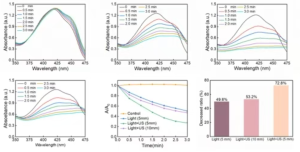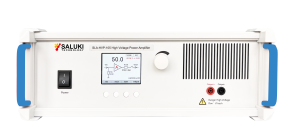Experiment name: Acoustic-optical synergistic enhancement experiment in deep tissue photodynamic therapy
Research direction: Acoustic-optical synergistic enhancement of phototherapy
Experiment content: Use SLA-HVP-105 high-voltage power amplifier to drive ultrasonic transducers to generate high-intensity focused acoustic fields, and guide scattered light focusing through acoustic wave pressure gradients, thereby improving the penetration depth and light energy transfer efficiency of 660nm therapeutic lasers in bionic tissue models
Test equipment: SLA-HVP-105 high voltage power amplifier, UV spectrophotometer, etc.

Figure 1. Experimental setup
Experimental process:
1. Construction of photosensitizer and probe system: Methylene blue (MB) was used as photosensitizer (PS), 1,3-diphenylisobenzofuran (DPBF) was used as singlet oxygen (102) detection probe, and 1,2-dibenzoylbenzene was generated through the specific irreversible reaction of DPBF and 102 to establish a photodynamic efficiency evaluation model. The DPBF solution was dropped into the MB solution, the photodynamic reaction was triggered by 660nm laser irradiation, and the absorbance change at 420nm was monitored in real time.
2. Set up a control group and an experimental group: The control group did not use ultrasound, and the experimental group used a SLA-HVP-105 high-voltage power amplifier to amplify the driving signal and generate focused ultrasound in the medium. Scattering phantoms with thicknesses of 5 mm and 10 mm were used to simulate the light transmission characteristics of biological tissues at different depths.
3. Environmental interference control and data collection: Record absorbance baseline data in a natural environment (without laser irradiation) to eliminate environmental interference. Use a spectrophotometer to quantitatively analyze the DPBE emission spectra (0-3min) under four experimental conditions (without laser irradiation, normal irradiation, and 5mm/10mm scattering phantom under ultrasound).
Experimental results:

1. Comparison of 102 generation efficiency: Control group (no sound field): 5mm scattering phantom caused the absorbance to decrease by 52.7%, and 10mm scattering phantom caused the absorbance to decrease by 54.2%. Experimental group (with sound field): The absorbance of 5mm scattering phantom decreased by 66.3% under the action of sound field, indicating that the synergy of sound and light significantly improved the utilization rate of light energy.
2. Verification of the synergistic mechanism of acoustic field regulation: The acoustic radiation force generated by the acoustic field acts on the scattering medium, causing the scattered light to focus, thereby increasing the light energy absorbed by MB, and the singlet oxygen yield increased by 25.7% compared with the control group (5mm scattering medium). In a 10mm thick scattering medium, the acoustic field regulation can still maintain a 54.2% absorbance reduction rate, proving that its penetration depth has doubled.
Power amplifier recommendation: SLA-HVP-105 high-voltage power amplifier



